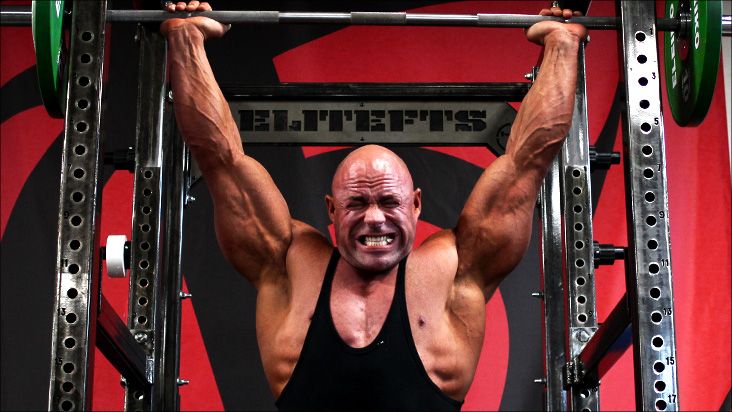by John Meadows - 01/22/2013

After years of dancing around with overhead pressing, I finally gave up on it.
Sayanora.
No matter how careful I was, overhead pressing would always beat up my rotators, which would lead to chronic shoulder pain and then I'd have to back off shoulders for a while.
Who needs that kind of frustration? Who needs that kind of pain? But then I stumbled onto something really cool.
A few years ago my partners and I were setting up a power rack for squats. The bar was loaded with 100 pounds, but the pins were set too high. I grabbed the loaded bar and pushed it forward against the rack and slid it up the frame until my arms locked out, which allowed my training partners to lower the J-hooks to my height.
As I was scraping the bar up the frame, I thought to myself that it felt pretty dang good. I made a mental note to myself to play around with this variation later.
The next day after working chest I started shoulders with side laterals. For my next exercise, I decided to test out the scrape the rack press.
I set up the long pins (the things that catch the bar if you drop it) to about chin level and put a bar on the pins. From there I slid the bar forward until it touched the back of the rack and then slid the weight up against the rack, flexing my delts at the top of the movement. It felt great and much more natural than the overhead press.
As I continued performing sets of scrape the rack press, the pump and intense burn I got from them was amazing.
Another thing I liked was that I didn't have to complete a balancing act with the bar like you do with regular overhead presses. You can simply stagger your stance to make a strong and stable base from which to drive the bar up. And, by wearing a belt, you make this lower-back friendly, as well.
There's just something about having a fixed plan of motion (pushing up and against the rack) that allows you to focus 100% on muscular contraction and applying brute force, as opposed to worrying about balance and remaining under the bar in the perfect position each time.
Over time, I've found that — coupled with side lateral variations — scrape the rack presses produce substantial growth in my delts with little to no risk of injury.
Also, I've found that a variation of the scrape the rack press is a great fix for underdeveloped traps. It really hits the entire shoulder and upper back/trap areas.
To really learn this lift, check out the video of John Schlecht and I performing scrape the rack press and its trap variation.
I think if you give these a try, you'll love them.
John Meadows' Scrape the Rack Press - YouTube

After years of dancing around with overhead pressing, I finally gave up on it.
Sayanora.
No matter how careful I was, overhead pressing would always beat up my rotators, which would lead to chronic shoulder pain and then I'd have to back off shoulders for a while.
Who needs that kind of frustration? Who needs that kind of pain? But then I stumbled onto something really cool.
A few years ago my partners and I were setting up a power rack for squats. The bar was loaded with 100 pounds, but the pins were set too high. I grabbed the loaded bar and pushed it forward against the rack and slid it up the frame until my arms locked out, which allowed my training partners to lower the J-hooks to my height.
As I was scraping the bar up the frame, I thought to myself that it felt pretty dang good. I made a mental note to myself to play around with this variation later.
The next day after working chest I started shoulders with side laterals. For my next exercise, I decided to test out the scrape the rack press.
I set up the long pins (the things that catch the bar if you drop it) to about chin level and put a bar on the pins. From there I slid the bar forward until it touched the back of the rack and then slid the weight up against the rack, flexing my delts at the top of the movement. It felt great and much more natural than the overhead press.
As I continued performing sets of scrape the rack press, the pump and intense burn I got from them was amazing.
Another thing I liked was that I didn't have to complete a balancing act with the bar like you do with regular overhead presses. You can simply stagger your stance to make a strong and stable base from which to drive the bar up. And, by wearing a belt, you make this lower-back friendly, as well.
There's just something about having a fixed plan of motion (pushing up and against the rack) that allows you to focus 100% on muscular contraction and applying brute force, as opposed to worrying about balance and remaining under the bar in the perfect position each time.
Over time, I've found that — coupled with side lateral variations — scrape the rack presses produce substantial growth in my delts with little to no risk of injury.
Also, I've found that a variation of the scrape the rack press is a great fix for underdeveloped traps. It really hits the entire shoulder and upper back/trap areas.
To really learn this lift, check out the video of John Schlecht and I performing scrape the rack press and its trap variation.
I think if you give these a try, you'll love them.
John Meadows' Scrape the Rack Press - YouTube





Comment